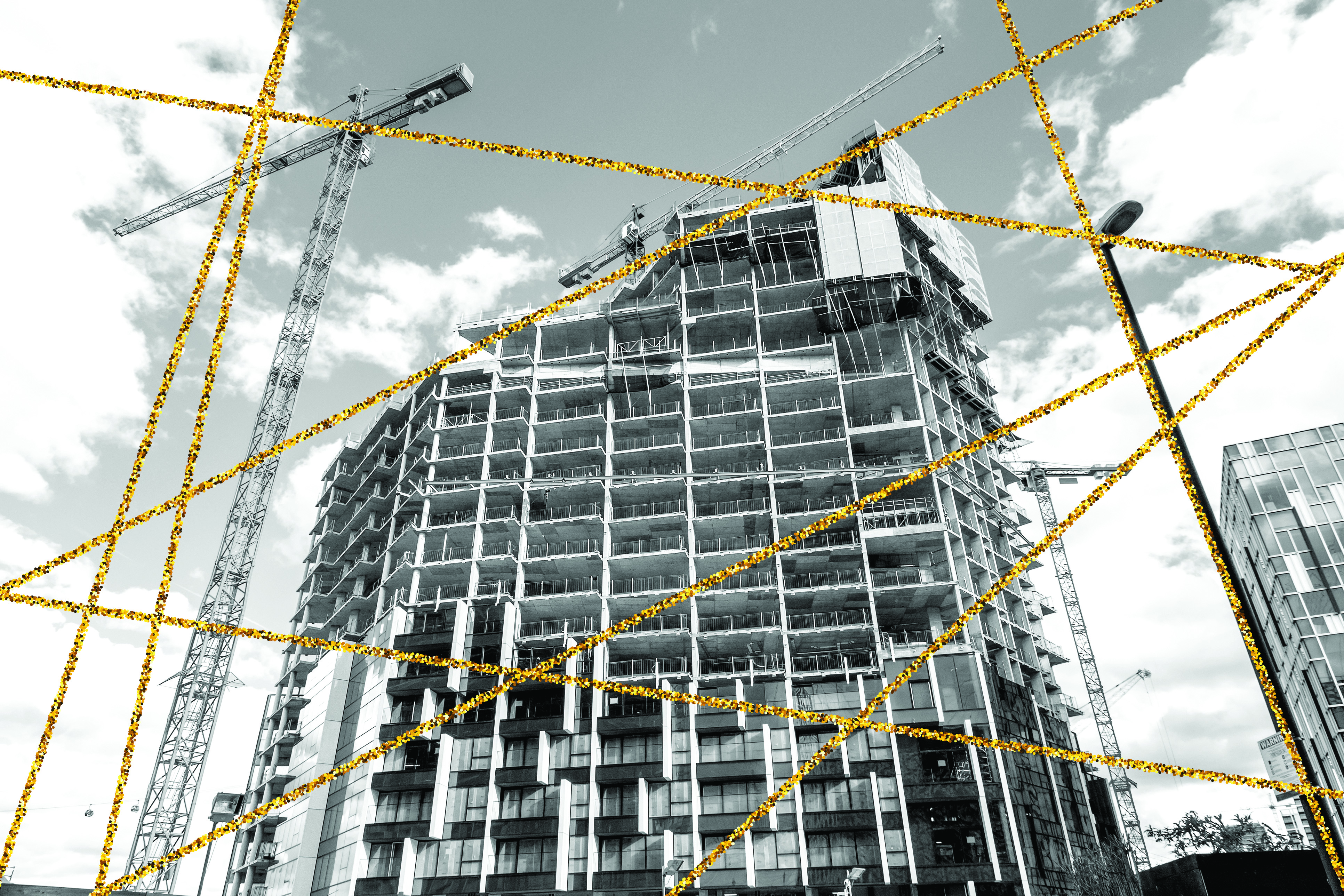
The government’s plans for reforming the building safety regulatory system are extensive and ambitious. Published last month in Building a Safer Future, the proposals build on the recommendations in Dame Judith Hackitt’s independent review of regulations and fire safety. In some cases, they go further. For example, the government is proposing the scope of the regulations is residential buildings above 18-metres high, rather than 30 metres, as stated in the Hackitt report.
Under the proposals, the construction industry will have to consider fire safety at every stage of the building life-cycle – from planning and design to construction and occupation. Failure to do so may prevent projects from being signed off by a building regulator. ‘There will be a huge amount of stress for the developer and occupier if the building can’t be occupied until the regulator signs it off,’ says Miller Hannah, partner and principal of fire engineering at Hoare Lea. ‘It will be for their own good, but there might be delays.’
The consultation document proposes making people accountable for fire safety during the building life-cycle. Five ‘dutyholder’ roles are proposed in the design and construction phase – client, principal designer, principal contractor, designer, and contractor – with safety responsibilities set out in law. During the occupation phase, an accountable person must appoint a building safety manager to carry out functions in accordance with the requirements of the building safety certificate and the safety case, which is the evidence showing that life-critical risks are being proactively managed.
“There needs to be clearer product descriptions, which are robust and honest on performance. We need less gobbledygook and more clarity”
There are three key points at which the dutyholder must demonstrate they are managing building safety risks appropriately before they can continue to the next stage of development. The first of these ‘gateways’ occurs before planning permission is granted, the second before construction begins, and the third before occupation.
The proposals refer to a ‘golden thread’ that runs through the whole life of the building. This involves making sure the design works and that the products procured support the design ethos. These products then need to be installed correctly and commissioned properly. The occupiers and building managers must also understand, and be able to maintain, the fire-safety features, and there must be an ongoing inspection regime.
Key to maintaining the golden thread is the quality of information that is passed to enable the person inheriting the risk to understand how the building operates, what layers of protection exist, and what needs to be done to manage risk in the future.
Building insurers rely on fire-safety information to assess building risk for professional indemnity cover. ‘Record keeping hasn’t been the forte of the construction sector. The golden thread – and the requirement for a fire-safety case – will force people to keep better information,’ says Thomas Roche, senior consultant for international codes and standards at FM Global. Finding relevant fire-safety information in buildings often felt like a voyage of discovery, Roche adds. ‘We have to figure out what information they have and, sometimes, information is missing or not in the right format. There is a lack of clarity.’

Thomas Roche and Gavin Dunn
Gavin Dunn, chief executive of the Chartered Association of Building Engineers (Cabe) says the golden thread of information means something different to everyone involved in buildings. ‘For contractors, it’s about recording changes made on site. That’s different from the information designers provide,’ he says. The information exists, but – adds Dunn – ‘we have to be much more methodical about how we present it’.
Roche agrees: ‘The data’s great, but unless you have a mechanism to interpret the information, it’s not helpful. The golden thread is about providing context. Clients need to know the reason for the fire-safety system – what it protects you against and what it means if you make a change.’
Hannah likens the information required to a car logbook. ‘I don’t need to know how the internal combustion engine works, I just need to know how to maintain the car.’
At the design and construction stage, the golden thread will consist of information and data collected as the building passes through the gateway points. At Gateway two, for example, the government proposes that dutyholders provide full plans produced by the principal designer, including a 3D digital model of the building and a fire and emergency file. The file should be updated and passed across to the person accountable for safety in the occupation phase.
Information handed over should include the construction control plan produced by the principal contractor, which describes how building safety and Building Regulations compliance will be maintained during the construction phase, and how change will be controlled and recorded. In occupation, the information included within the golden thread will be different for new and existing buildings. For new buildings, it will initially be comprising information collected through the gateway points during the design and construction phase. For existing buildings, the content will be started during the building safety registration process.
Hackitt’s independent review noted that, in the current system, there is a lack of clarity on responsibility and requirements across areas such as product performance, traceability and labelling. It also stated that there was a need to clarify roles and responsibilities in higher-risk residential buildings, and to strengthen national regulatory oversight and market surveillance of construction products.
Building a Safer Future seeks to make explicit roles and responsibilities in legislation, particularly in relation to the performance of products that can have a critical impact on safety. It proposes these products are put on an ‘inventory list’.
Acting chief executive of the Construction Products Association (CPA) Peter Caplehorn chaired the Regulations working group for Hackitt’s independent review, and sat on both the products and the golden thread working groups. ‘There need to be clearer product descriptions, which are robust and honest on performance,’ he says. ‘We need less gobbledygook and more clarity.
‘For example, we don’t want to read that a product has been “tested to” a particular standard, or is “in compliance with”. It’s not clear. Information should state that the product “has been tested to this standard and passed under the following criteria”. Or it has been “assessed in accordance to this scheme and these are the results”.’
“Engineering and architecture in the public domain are a mystery to most people and, after Grenfell, public confidence has taken a knock”
Caplehorn is working on a marketing integrity group that intends to establish a code of practice, in the autumn for technical and marketing literature. ‘It’s a plain-English standard that will bring an element of quality control. It’s a voluntary scheme, but the legitimate parts of the industry will sign up for it,’ says Caplehorn. ‘The code means that, if you are achieving performance in alignment with a certain standard, it has to be clear that it does do that, and has passed an appropriate test.’ (CIBSE is contributing to the code, and members are welcome to comment via email at technical@cibse.org).
The standard is meant to address the issue of substituting products with ones with different performance characteristics, says Caplehorn. ‘The consultation is talking about people having real, tangible responsibility – so they will need to make sure the substitution is a sensible one and is not offering poorer performance. The new code will make sure performance and characteristics are clear and transparent.’
In the proposals, the government states that it is working with the British Standards Institution, the UK Accreditation Service, and wider industry to develop minimum requirements and establish clear standards for independent assurance schemes. It envisages an umbrella BSI standard specification that can apply across all construction product schemes.
Currently, there are no minimum requirements for independent assurance schemes and, as a result, there can be a lack of clarity on the risks these schemes are mitigating – whether that be integrity of the design or constancy of the manufacture.
Digital records
The product information will form part of the digital record that will be passed between dutyholders and, finally, to the building safety manager. Roche says this should be a living document: ‘One of the tools of the trade.’
The proposals say that using BIM would make it easier to record key changes to a building’s design and to the products and materials used. ‘While we do not plan to mandate that particular software is used to store information, we may choose to mandate that the golden thread of building information complies with BIM standards,’ the proposals said. A pilot involving housing association L&Q is exploring the feasibility of creating BIM models of existing residential towers (See panel, ‘Creating an evidence base for existing buildings’).
Creating an evidence base for existing buildings
The level of information held in a digital format for existing buildings varies widely. To understand how enough data could be gathered to form a safety case for existing buildings, housing association L&Q has selected a team of specialists – architect, fire engineer, structural engineer, BIM consultant and digital survey company – to consider three existing higher risk residential buildings (HRRBs). These ranged from a 1960s tower block to a new build.
It is using a range of data collection systems to find the most effective way of closing the information gap. These include using laser point cloud scans and photogrammetry to construct a 3D Revit model for each building with the aim of creating a ‘digital twin’ of the existing building.
The project will test how practical it is to use the ‘digital twin’ as the evidence base for the safety case. It will also explore if there are other benefits the ‘digital twin’ can provide for asset and building management.
The pilot scheme is important as the proposals state that in future it expects a safety case will be required to be submitted to the building safety regulator for all existing HRRBs.
While high-end buildings may have the resources to use BIM and create digital twins, Dunn says, most won’t. ‘It will have to be a simple information set that can be accessed by a mid-level technician on a laptop,’ he adds. Whatever form it takes, the information will be made available to the building end users. A key proposal of the report is to put residents at the centre of the regulatory process. This means having an open, transparent engagement strategy, where fire-safety information is given in a clear, accessible format by the building safety manager. This will be a mandatory condition of the building safety certificate.
Building a Safer Future proposes that part of the information in the golden thread be made available to residents, the building safety regulator and parliament. This ‘key dataset’ will be maintained through the life-cycle of the building, and could include a unique building identifier, as well as location, size, building type, current and past dutyholders, accountable persons and building safety managers, plus minimal information on safety features such as fire doors and systems.
‘This is an opportunity to engage with end users,’ says CIBSE past president and Spie director of energy and engineering George Adams. ‘The perception of engineering and architecture in the public domain is a mystery to most people and, after Grenfell, public confidence has taken a knock.’ Arup associate director Nick Troth agrees that ‘this objective is the right one’. ‘If residents are concerned about fire safety in buildings in which they live, there should be a route to raising concerns.’
